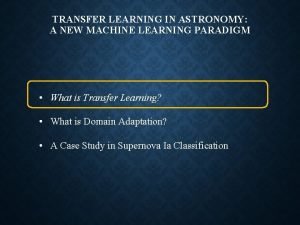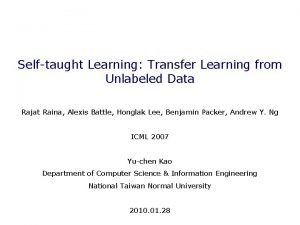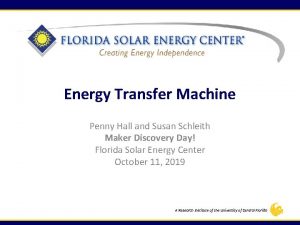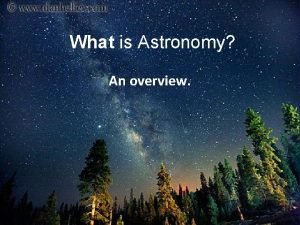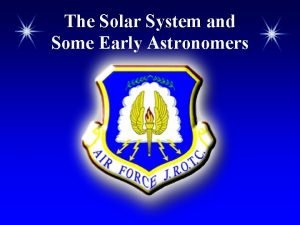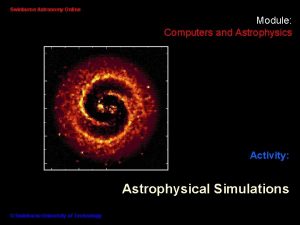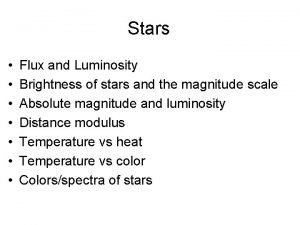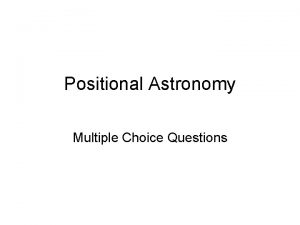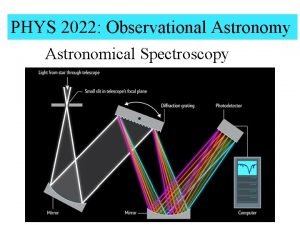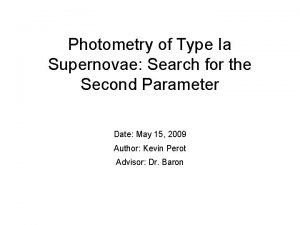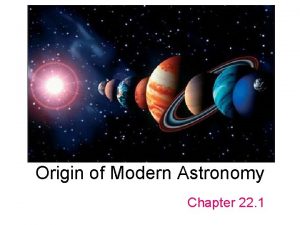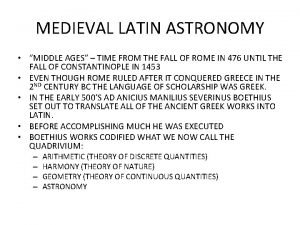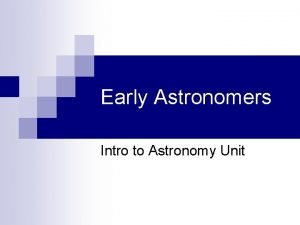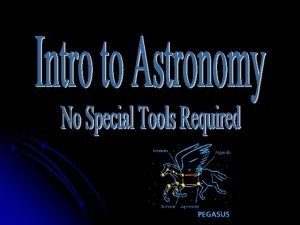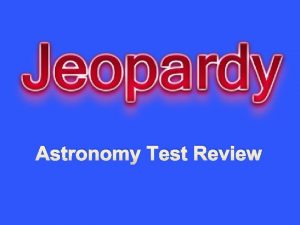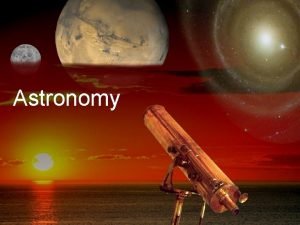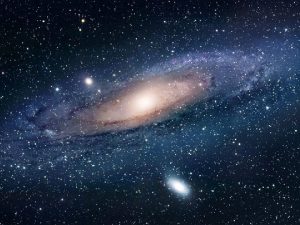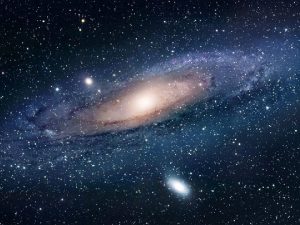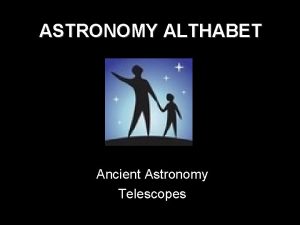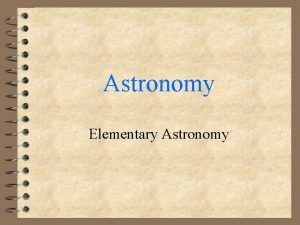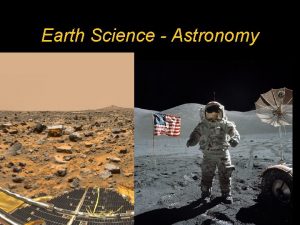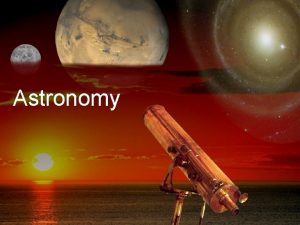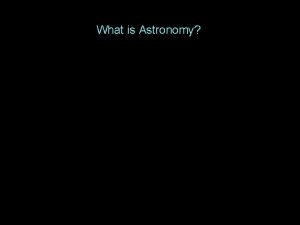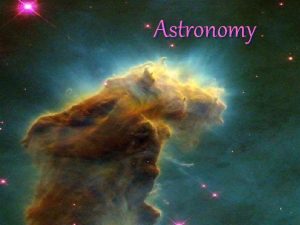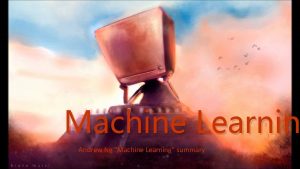TRANSFER LEARNING IN ASTRONOMY A NEW MACHINE LEARNING






































- Slides: 38

TRANSFER LEARNING IN ASTRONOMY: A NEW MACHINE LEARNING PARADIGM • What is Transfer Learning? • What is Domain Adaptation? • A Case Study in Supernova Ia Classification

MOTIVATION TRANSFER LEARNING Motivation for transfer learning • The goal is to transfer knowledge gathered from previous experience. • Also called Inductive Transfer or Learning to Learn. Once a predictive model is built, there are reasons to believe the model will cease to be valid at some point in time. Source Domain Target Domain

TRADITIONAL APPROACH TO CLASSIFICATION DB 1 Learning System DB 2 Learning System DBn Learning System

TRANSFER LEARNING DB 1 DB 2 Source domain DB new Target domain Learning System Knowledge Learning System

TRANSFER LEARNING Scenarios: 1. Labeling in a new domain is costly. DB 1 (labeled) Classification of Cepheids DB 2 (unlabeled) Classification of Long Period Variable Stars LPV

TRANSFER LEARNING Scenarios: 2. Data is outdated. Model created with one survey but a new survey is now available. Survey 1 Survey 2 ? Learning System

MULTITASK LEARNING: Train in Parallel with Combined Architecture Figure obtained from Brazdil, et. Al. Metalearning: Applications to Data Mining, Chapter 7, Springer, 2009.

KNOWLEDGE OF PARAMETERS Assume prior distribution of parameters Source domain Target domain Learn parameters and adjust prior distribution Learn parameters using the source prior distribution.

KNOWLEDGE OF PARAMETERS Find coefficients ws using SVMs Find coefficients w. T using SVMs initializing the search with ws

FEATURE TRANSFER Identify common Features to all tasks

TRANSFER LEARNING IN ASTRONOMY: A NEW MACHINE LEARNING PARADIGM • What is Transfer Learning? • What is Domain Adaptation? • A Case Study in Supernova Ia Classification

DOMAIN ADAPTATION Source Class 1 Source Class 2 Target

DOMAIN ADAPTATION Target Class 1 Target Class 2

DOMAIN ADAPTATION Source Domain Labeled Source Data Target Domain Unlabeled Target Data Domain Adaptation algorithm Test Train Classifier Predicted Labels

COVARIATE SHIFT Covariate Shift: PS(X) ≠ PT(X) , PS(Y|X) = PT(Y|X) Source Class 1 Source Class 2 Target Class 1 Target Class 2

INSTANCE BASED METHODS Source Class 1 Source Class 2 Target

INSTANCE BASED METHODS Source Class 1 Source Class 2 Target

INSTANCE BASED METHODS Source Class 1 Data Source Class 2 Data Target Data Source Model Target Model

INSTANCE BASED METHODS Source Class 1 Source Class 2 Target Class 1 Target Class 2

INSTANCE BASED METHODS Target Class 1 Target Class 2

FEATURE-BASED METHODS When source instances cannot represent the target distribution at all in the parameter space, we can project source and target datasets to common feature space (i. e. , we can align both datasets).

ASSUMPTIONS DOMAIN ADAPTATION O. K. NO Source Class 1 Source Class 2 Target

ACTIVE LEARNING DB new Target Domain (unlabeled data) Active Learning Expert labels (few) examples What examples need labeling to guarantee a hypothesis with small predictive error? Learning System

ACTIVE LEARNING Unlabeled Target Point Queried Data Target Class 1 Target Class 2

ACTIVE LEARNING Unlabeled Target Point Queried Data Target Class 1 Target Class 2

ACTIVE LEARNING Unlabeled Target Point Queried Data Target Class 1 Target Class 2

ACTIVE LEARNING Unlabeled Target Point Queried Data Target Class 1 Target Class 2

ACTIVE LEARNING Unlabeled Target Point Queried Data Target Class 1 Target Class 2

DOMAIN ADAPTATION + ACTIVE LEARNING Source Domain Target Domain Labeled Source Data Domain Adaptation Predicted Labels Labeled Target Data Unlabeled Target Data Active Learning Test Train Classifier

TRANSFER LEARNING IN ASTRONOMY: A NEW MACHINE LEARNING PARADIGM • What is Transfer Learning? • What is Domain Adaptation? • A Case Study in Supernova Ia Classification

SOURCE AND TARGET USING SUPERNOVA DATASETS • Spectroscopy • Enable parameter inference from astronomical data • determine the presence of individual chemical elements (spectral lines) • infer the distance (redshift) to extragalactic sources • Expensive and time-consuming process • Unfeasible to obtain measurements for all cataloged objects • Photometry: • Low resolution counterpart • Summarize the intensity of electromagnetic radiation in a handful of broad wavelength windows (filters). • Information on individual spectral lines is not accessible.

OVERVIEW Automatic SN Classification Using Machine Learning Training data labeled through spectroscopy Test data obtained through photometry Domain Adaptation Active Learning

SAMPLE SELECTION BIAS Training Set Test Set Brighter nearby objects (spectroscopy) Extensive Deeper Surveys (photometry) Main assumption in supervised learning is not warranted

AUTOMATED CLASSIFICATION OF SUPERNOVA IA How can we take advantage of existing supernova datasets already classified using spectroscopy to develop an automated classification method using new photometric surveys?

EXPERIMENTAL SETUP • Data Acquisition: • Simulated data stemming from the Supernova Photometric Classification Challenge, traditionally called post-SNPCC • Mimic the characteristics of Dark Energy Survey (DES) data • Select only objects having at least 3 observed epochs per filter, with at least 1 of them being before -3 days and at least 1 after +24 days since maximum brightness. • In each filter, light curve fitting is performed using Gaussian process regression, and the resulting function is sampled with a window of 1 day. No quality cuts are imposed (SNR>0). • Datasets: • Source Dataset - Labeled (Photometric) • Test Dataset – Unlabeled (Spectroscopic) 35

EXPERIMENTAL SETUP • Dimensionality Reduction : • Original : 108 Features • For this research : 20 Features, reduced by KPCA • Active Learning : • 50% Pool, 50% Test • 10 Pairs • 10 Runs

RESULTS: ACCURACY AND PURITY Accuracy and Precision on Target Data using Domain Adaptation and Active Learning.

THANK YOU!
 Learning astronomy by doing astronomy activity 1 answers
Learning astronomy by doing astronomy activity 1 answers Learning astronomy by doing astronomy activity 7 answers
Learning astronomy by doing astronomy activity 7 answers Learning astronomy by doing astronomy activity 1 answers
Learning astronomy by doing astronomy activity 1 answers Deep learning spectroscopy
Deep learning spectroscopy Self-taught learning: transfer learning from unlabeled data
Self-taught learning: transfer learning from unlabeled data A disturbance that transfers energy
A disturbance that transfers energy Concept learning task in machine learning
Concept learning task in machine learning Analytical learning in machine learning
Analytical learning in machine learning Pac learning model in machine learning
Pac learning model in machine learning Machine learning t mitchell
Machine learning t mitchell Inductive vs analytical learning
Inductive vs analytical learning Inductive and analytical learning problem
Inductive and analytical learning problem Instance based learning in machine learning
Instance based learning in machine learning Inductive learning machine learning
Inductive learning machine learning First order rule learning in machine learning
First order rule learning in machine learning Lazy learner and eager learner
Lazy learner and eager learner Cmu machine learning
Cmu machine learning Energy transfer machine
Energy transfer machine Finite state machine vending machine example
Finite state machine vending machine example Mealy or moore machine
Mealy or moore machine Mealy to moore conversion
Mealy to moore conversion Chapter 10 energy work and simple machines answer key
Chapter 10 energy work and simple machines answer key Cuadro comparativo e-learning y b-learning
Cuadro comparativo e-learning y b-learning What is astronomy
What is astronomy Claudius ptolemy astronomy contributions
Claudius ptolemy astronomy contributions Aristotle astronomy
Aristotle astronomy Swinburne astronomy
Swinburne astronomy Mizar luminosity
Mizar luminosity Flux and luminosity
Flux and luminosity Clea exercises
Clea exercises Astronomy questions and answers multiple choice
Astronomy questions and answers multiple choice Astronomy
Astronomy Distance ladder astronomy
Distance ladder astronomy Origin of modern astronomy chapter 22
Origin of modern astronomy chapter 22 Astronomy in medieval times
Astronomy in medieval times Geology earth science definition
Geology earth science definition Claudius ptolemy astronomy contributions
Claudius ptolemy astronomy contributions Cuhk astronomy
Cuhk astronomy Astronomy vs astrology worksheet
Astronomy vs astrology worksheet



